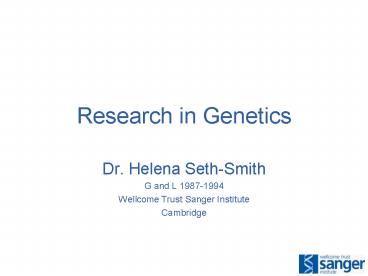Research in Genetics - PowerPoint PPT Presentation
1 / 65
Title:
Research in Genetics
Description:
Title: PowerPoint Presentation Author: Wellcome Trust Sanger Institute Last modified by: hss Created Date: 12/2/2004 4:30:22 PM Document presentation format – PowerPoint PPT presentation
Number of Views:108
Avg rating:3.0/5.0
Title: Research in Genetics
1
Research in Genetics
- Dr. Helena Seth-Smith
- G and L 1987-1994
- Wellcome Trust Sanger Institute
- Cambridge
2
What Ill talk about...
- Science as a career
- Career structure in science
- My Ph.D. project
- The Sanger Institute
- A day in the life...
- Questions
3
Science as a career
4
Science as a Career
5
Interesting
6
Use your brain
7
Continue learning
8
Discover the unknown, and pursue it
9
Expert in your field
10
Freedom of research
11
Flexible work
12
Variety within work
13
Active
14
Not a traditional job for life
15
You can travel with jobs
16
You can travel with conferences
17
South Africa - Kruger
18
Zimbabwe Victoria Falls
19
South Africa Cape Town
20
Puerto Rico
21
Young and varied people
- casual
22
Further personal development
23
You dont do it for the money
24
Science has geeks
25
But other professions have issues too
26
Career structure in science
27
Career Structure in Science(not that you have to
decide early on)
Undergraduate degree
(Professorship)
Ph.D.
Lectureship
- Postdoctoral position
Second postdoc...
28
Undergraduate degree
- Format lectures and practicals
- Natural Sciences for choice of subjects
- First year cell biology, physiology, chemistry,
maths
- Second year molecular cell biology,
biochemistry, - history and philosophy of science
- Third year Genetics
- Can lead to a number of careers
- Need 2.1 or above for PhD
29
Ph.D.
- Format research (papers and lab work)
- Choose a subject you are interested in
- Autonomy planning
- Social life, sport, teaching ...
- Produce a MAJOR piece of work (STRESS!!)
- Useful skills for other jobs
30
Postdoctoral position
- Continue in same field or choose to learn another
- Location, location, location
- 2-3 years to do publishable research
31
Second postdoc...
- Ditto
- And maybe ditto again
- Find your own niche / area of interest
- Or move into industrial science
32
Lectureship
- Own research group
- and teaching
- Permanent post
- More permanent location
- Fewer women
33
(Professorship)
- Highest level in academia
- Head of Department
34
My Ph.D. ProjectMicrobial Degradation of RDX
35
Bacteria eating explosives
36
Explosives are dangerous...
...to our health
37
Explosive polluted sites
38
Explosives in bombs
39
Seeing bacteria eating explosives
Where RDX has been eaten and removed, agar is
clear
RDX makes the agar on the plate look white and
grainy
40
Up close and personal
5mm
(Electron microscopes dont show orange!)
41
Growth curve
42
The gene I discovered
Gene..... makes... Protein
43
Gene in plants
Normal, wild type plants - get sicker as they
are grown with more explosive
Plants with my gene in - healthy when grown
with explosive
more explosive in the soil
44
The future
45
The Wellcome Trust Sanger Institute
- www.sanger.ac.uk
46
The Sanger Institute
AIM To sequence and analyse genomes, for future
research on human biology and disease
47
Organisms with Sequenced Genomes
48
From organism to DNA...
49
...to sequence
50
A day in the life...
51
A day in the life
52
A day in the life
53
A day in the life
54
A day in the life
55
A day in the life
56
A day in the life
57
A day in the life
58
Conclusion
- Worthwhile career
- Plenty of time to decide
- Huge variety of research projects
59
Thanks for your attention!
Slides and contact details at www.sanger.ac.uk/Us
ers/hss/
- Questions?
60
DNA double helix
61
My work at the Sanger Institute
62
Comparing bacteria
Nice bacterium
Nasty, infectious bacterium Very similar to nice
bacterium What are the differences? Can the
genes tell us about infection?
63
Name a bug after yourself!
- Walter H Burkholder
- Burkholderia cepacia
- Degrades pollutants, infects plants, infects
human lungs, helps crops
64
(No Transcript)
65
(No Transcript)































